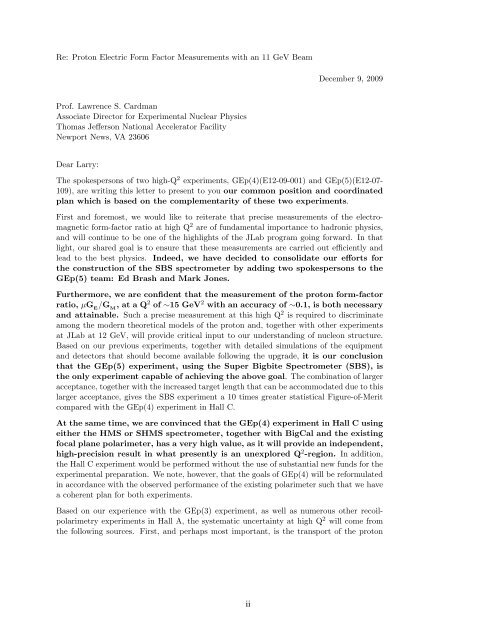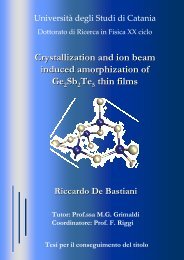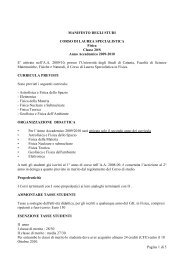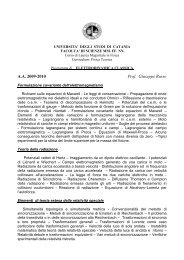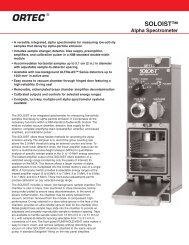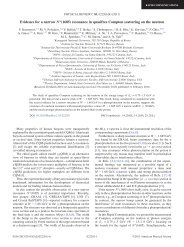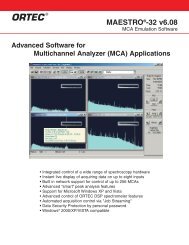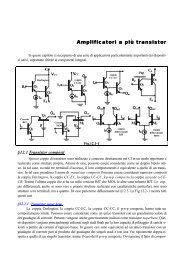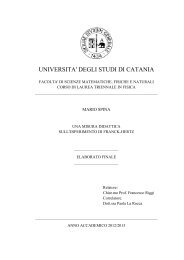Update on E12-07-109: Large Acceptance Proton Form Factor ... - Infn
Update on E12-07-109: Large Acceptance Proton Form Factor ... - Infn
Update on E12-07-109: Large Acceptance Proton Form Factor ... - Infn
You also want an ePaper? Increase the reach of your titles
YUMPU automatically turns print PDFs into web optimized ePapers that Google loves.
Re: Prot<strong>on</strong> Electric <strong>Form</strong> <strong>Factor</strong> Measurements with an 11 GeV Beam<br />
Prof. Lawrence S. Cardman<br />
Associate Director for Experimental Nuclear Physics<br />
Thomas Jeffers<strong>on</strong> Nati<strong>on</strong>al Accelerator Facility<br />
Newport News, VA 23606<br />
Dear Larry:<br />
December 9, 2009<br />
The spokespers<strong>on</strong>s of two high-Q 2 experiments, GEp(4)(<strong>E12</strong>-09-001) and GEp(5)(<strong>E12</strong>-<strong>07</strong>-<br />
<strong>109</strong>), are writing this letter to present to you our comm<strong>on</strong> positi<strong>on</strong> and coordinated<br />
plan which is based <strong>on</strong> the complementarity of these two experiments.<br />
First and foremost, we would like to reiterate that precise measurements of the electromagnetic<br />
form-factor ratio at high Q 2 are of fundamental importance to hadr<strong>on</strong>ic physics,<br />
and will c<strong>on</strong>tinue to be <strong>on</strong>e of the highlights of the JLab program going forward. In that<br />
light, our shared goal is to ensure that these measurements are carried out efficiently and<br />
lead to the best physics. Indeed, we have decided to c<strong>on</strong>solidate our efforts for<br />
the c<strong>on</strong>structi<strong>on</strong> of the SBS spectrometer by adding two spokespers<strong>on</strong>s to the<br />
GEp(5) team: Ed Brash and Mark J<strong>on</strong>es.<br />
Furthermore, we are c<strong>on</strong>fident that the measurement of the prot<strong>on</strong> form-factor<br />
ratio, µG E /G M , at a Q 2 of ∼15 GeV 2 with an accuracy of ∼0.1, is both necessary<br />
and attainable. Such a precise measurement at this high Q 2 is required to discriminate<br />
am<strong>on</strong>g the modern theoretical models of the prot<strong>on</strong> and, together with other experiments<br />
at JLab at 12 GeV, will provide critical input to our understanding of nucle<strong>on</strong> structure.<br />
Based <strong>on</strong> our previous experiments, together with detailed simulati<strong>on</strong>s of the equipment<br />
and detectors that should become available following the upgrade, it is our c<strong>on</strong>clusi<strong>on</strong><br />
that the GEp(5) experiment, using the Super Bigbite Spectrometer (SBS), is<br />
the <strong>on</strong>ly experiment capable of achieving the above goal. The combinati<strong>on</strong> of larger<br />
acceptance, together with the increased target length that can be accommodated due to this<br />
larger acceptance, gives the SBS experiment a 10 times greater statistical Figure-of-Merit<br />
compared with the GEp(4) experiment in Hall C.<br />
At the same time, we are c<strong>on</strong>vinced that the GEp(4) experiment in Hall C using<br />
either the HMS or SHMS spectrometer, together with BigCal and the existing<br />
focal plane polarimeter, has a very high value, as it will provide an independent,<br />
high-precisi<strong>on</strong> result in what presently is an unexplored Q 2 -regi<strong>on</strong>. In additi<strong>on</strong>,<br />
the Hall C experiment would be performed without the use of substantial new funds for the<br />
experimental preparati<strong>on</strong>. We note, however, that the goals of GEp(4) will be reformulated<br />
in accordance with the observed performance of the existing polarimeter such that we have<br />
a coherent plan for both experiments.<br />
Based <strong>on</strong> our experience with the GEp(3) experiment, as well as numerous other recoilpolarimetry<br />
experiments in Hall A, the systematic uncertainty at high Q 2 will come from<br />
the following sources. First, and perhaps most important, is the transport of the prot<strong>on</strong><br />
ii


